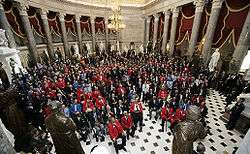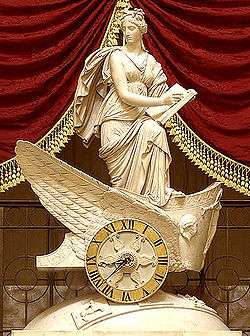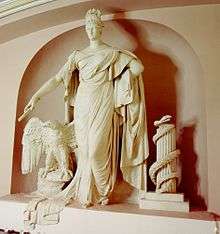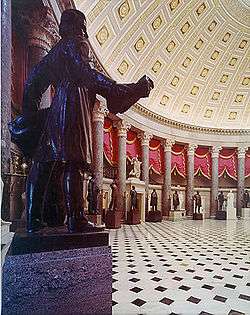National Statuary Hall
National Statuary Hall is a chamber in the United States Capitol devoted to sculptures of prominent Americans. The hall, also known as the Old Hall of the House, is a large, two-story, semicircular room with a second story gallery along the curved perimeter. It is located immediately south of the Rotunda. The meeting place of the U.S. House of Representatives for nearly 50 years (1807–1857), after a few years of disuse in 1864 it was repurposed as a statuary hall; this is when the National Statuary Hall Collection was established.[1] By 1933 the collection had outgrown this single room, and a number of statues are placed elsewhere within the Capitol.
.jpg)

Description
The Hall is built in the shape of an ancient amphitheater and is one of the earliest examples of Neoclassical architecture in America. While most wall surfaces are painted plaster, the low gallery walls and pilasters are sandstone. Around the room's perimeter stand colossal columns of variegated breccia marble quarried along the Potomac River. The Corinthian capitals of white marble were carved in Carrara, Italy. A lantern in the fireproof cast-steel ceiling admits natural light into the Hall. The chamber floor is laid with black and white marble tiles; the black marble was purchased specifically for the chamber, while the white marble was scrap material from the Capitol extension project.[2]


Only two of the many statues presently in the room were commissioned for display in the original Hall of the House. Enrico Causici's neoclassical plaster Liberty and the Eagle looks out over the Hall from a niche above the colonnade behind what was once the Speaker's rostrum. The sandstone relief eagle in the frieze of the entablature below was carved by Giuseppe Valaperta. Above the door leading into the Rotunda is the Car of History by Carlo Franzoni. This neoclassical marble sculpture depicts Clio, the Muse of History, riding in the chariot of Time and recording events in the chamber below. The wheel of the chariot contains the chamber clock; the works are by Simon Willard.[1]
History
This chamber is the second hall and third meeting place built for the House of Representatives in this location. Prior to this, the House members met in a squat, oval, temporary building known as "the Oven,"[3] which had been hastily erected in 1801. The first permanent Hall, designed by Benjamin Henry Latrobe, was completed in 1807; however, it was destroyed when invading British troops burned the Capitol in August, 1814 during the War of 1812. The Hall was rebuilt in its present form by Latrobe and his successor, Charles Bulfinch, between 1815 and 1819. Unfortunately, the smooth, curved ceiling promoted annoying echoes, making it difficult to conduct business. Various attempts to improve the acoustics, including hanging draperies and reversing the seating arrangement, proved unsuccessful. The only solution to this problem was to build an entirely new Hall, one in which debates could be easily understood. In 1850, a new Hall was authorized, and the House moved into its present chamber in the new House wing in 1857.[1]
Many important events took place in this Chamber while it served as the Hall of the House. It was in this room in 1824 that the Marquis de Lafayette became the first foreign citizen to address Congress. Presidents James Madison, James Monroe, John Quincy Adams, Andrew Jackson, and Millard Fillmore were inaugurated here. John Quincy Adams, in particular, has long been associated with the Chamber. It was here in 1825 that he was elected president by the House of Representatives, none of the candidates having secured a majority of electoral votes. Following his presidency, Adams served as a Member in the Hall for 17 years. He collapsed at his desk from a stroke on February 21, 1848, and died two days later in the adjoining office, at the time, of the Speaker of the House.[1]


The fate of the vacated Hall remained uncertain for many years, although various proposals were put forth for its use. Perhaps the simplest was that it be converted into additional space for the Library of Congress, which was still housed in the Capitol. More drastic was the suggestion that the entire Hall be dismantled and replaced by two floors of committee rooms. Eventually, the idea of using the chamber as an art gallery was approved, and works intended for the Capitol extensions were put on exhibit; among these was the plaster model for the Statue of Freedom, which was later cast in bronze for the Capitol dome. The lack of wall space effectively prevented the hanging of large paintings, but the room seemed well suited to the display of statuary.[1]
In 1864, in accordance with legislation sponsored by Representative Justin Morrill, Congress invited each state to contribute two statues of prominent citizens for permanent display in the room, which was renamed National Statuary Hall. The legislation also provided for the replacement of the chamber's floor, which was leveled and covered with the marble tile currently in the Hall. This modification, along with the replacement of the original wooden ceiling (which was painted to simulate three-dimensional coffering) with the present one in the early 20th century, eliminated most of the echoes that earlier plagued the room.[1]
The first statue was placed in 1870. By 1971, all 50 states had contributed at least one statue, and by 1990, all but five states had contributed two statues. Initially all of the state statues were placed in the Hall. As the collection expanded, however, it outgrew the Hall, and in 1933, Congress authorized the display of the statues throughout the building for both aesthetic and structural reasons. Presently, 38 statues are located in National Statuary Hall.[1]
The room was partially restored in 1976 for the bicentennial celebration. At that time, the original fireplaces were uncovered and replicas of early mantels were installed. Reproductions of the chandelier, sconces, and red draperies were created for the restoration project based on The House of Representatives, an oil painting by Samuel F.B. Morse done in 1822, which now hangs in the Corcoran Gallery of Art. Bronze markers were placed on the floor to honor the presidents who served in the House of Representatives while it met here.[1]
In 2008, 23 statues were moved from the hall to the new Capitol Visitor Center.[4]
Today, Statuary Hall is one of the most visited rooms in the Capitol. It is visited by hundreds of tourists each day and continues to be used for ceremonial occasions. Special events held in the room include activities honoring foreign dignitaries and every four years Congress hosts a newly inaugurated President of the United States for a luncheon.[1]
Statues

The following is an alphabetical list of the people depicted in the statues, along with the state represented by each statue. Note that some statues have been replaced at the request of the states over time.
- Samuel Adams, Massachusetts
- Ethan Allen, Vermont
- Stephen F. Austin, Texas
- Charles Brantley Aycock, North Carolina (to be replaced by Billy Graham)
- Edward L. Bartlett, Alaska
- William Henry Harrison Beadle, South Dakota
- Thomas Hart Benton, Missouri (to be replaced by President Harry S. Truman)
- Francis Preston Blair, Jr., Missouri
- William Borah, Idaho
- Norman Borlaug, Iowa
- John Burke, North Dakota
- John C. Calhoun, South Carolina
- Charles Carroll, Maryland
- Lewis Cass, Michigan
- Dennis Chavez, New Mexico
- James Paul Clarke, Arkansas (to be replaced by Johnny Cash)
- Henry Clay, Kentucky
- John M. Clayton, Delaware
- George Clinton, New York
- Jacob Collamer, Vermont
- Father Damien, Hawaii
- Jefferson Davis, Mississippi
- Thomas Edison, Ohio
- Dwight D. Eisenhower, Kansas
- Philo T. Farnsworth, Utah (to be replaced by Martha Hughes Cannon)
- Gerald Ford, Michigan
- Robert Fulton, Pennsylvania
- James A. Garfield, Ohio
- James Zachariah George, Mississippi
- Barry Goldwater, Arizona
- John Gorrie, Florida
- Nathanael Greene, Rhode Island
- Ernest Gruening, Alaska
- Hannibal Hamlin, Maine
- Wade Hampton III, South Carolina
- John Hanson, Maryland
- Samuel Houston, Texas
- John James Ingalls, Kansas
- Andrew Jackson, Tennessee
- Mother Joseph, Washington
- Kamehameha I, Hawaii
- Philip Kearny, New Jersey
- Helen Keller, Alabama
- John E. Kenna, West Virginia
- William King, Maine
- Fr. Eusebio Kino, Arizona
- Samuel Jordan Kirkwood, Iowa
- Robert M. La Follette, Sr., Wisconsin
- Jason Lee, Oregon
- Robert Edward Lee, Virginia
- Robert R. Livingston, New York
- Crawford W. Long, Georgia
- Huey P. Long, Louisiana
- Fr. Jacques Marquette, Wisconsin
- Patrick Anthony McCarran, Nevada
- Ephraim McDowell, Kentucky
- John McLoughlin, Oregon
- Esther Hobart Morris, Wyoming
- Julius Sterling Morton, Nebraska (to be replaced by Willa Cather)
- Oliver Hazard Perry Morton, Indiana
- John Peter Gabriel Muhlenberg, Pennsylvania
- Rosa Parks, not representing any state
- Francis Harrison Pierpont, West Virginia
- Po'pay, New Mexico
- Jeannette Rankin, Montana
- Ronald Reagan, California
- Henry Mower Rice, Minnesota
- Caesar Rodney, Delaware
- Will Rogers, Oklahoma
- Uriah Milton Rose, Arkansas (to be replaced by Daisy Lee Gatson Bates)
- Charles Marion Russell, Montana
- Florence R. Sabin, Colorado
- Sacagawea, North Dakota
- Maria Sanford, Minnesota
- Sequoyah, Oklahoma
- Junipero Serra, California
- John Sevier, Tennessee
- Roger Sherman, Connecticut
- James Shields, Illinois
- George Laird Shoup, Idaho
- Edmund Kirby Smith, Florida (to be replaced by Mary McLeod Bethune)
- Standing Bear, Nebraska
- John Stark, New Hampshire
- Alexander H. Stephens, Georgia
- Richard Stockton, New Jersey
- John L. Swigert, Colorado
- Jonathan Trumbull, Connecticut
- Zebulon B. Vance, North Carolina
- Lewis Wallace, Indiana
- Joseph Ward, South Dakota
- Washakie, Wyoming
- George Washington, Virginia
- Daniel Webster, New Hampshire
- Joseph Wheeler, Alabama
- Edward Douglass White, Louisiana
- Marcus Whitman, Washington
- Frances E. Willard, Illinois
- Roger Williams, Rhode Island
- Sarah Winnemucca, Nevada
- John Winthrop, Massachusetts
- Brigham Young, Utah
Replaced statues
- George Washington Glick, Kansas (removed in favor of Dwight D. Eisenhower in 2003)
- Thomas Starr King, California (removed in favor of Ronald Reagan in 2009)
- Jabez Lamar Monroe Curry, Alabama (removed in favor of Helen Keller in 2009); see Statue of Jabez Lamar Monroe Curry
- Zachariah Chandler, Michigan (removed in favor of Gerald R. Ford in 2011)
- James Harlan, Iowa (removed in favor of Norman Borlaug in 2014)[5]
- William Jennings Bryan, Nebraska (removed in favor of Chief Standing Bear in 2019)[6]
- John Campbell Greenway, Arizona (removed in favor of Barry M. Goldwater in 2015)[7]
- William Allen, Ohio (removed in favor of Thomas A. Edison in 2016); see Statue of William Allen
- On February 28, 2018, the governor of North Carolina requested from the Architect of the Capitol replacement of the statue of Charles Brantley Aycock with one of evangelist Billy Graham, pursuant to legislation signed in 2015.[8]
- On March 19, 2018, the governor of Florida signed legislation to replace the statue of Confederate General Edmund Kirby Smith with one of the African-American educator and Civil Rights advocate, Mary McLeod Bethune.[9]
- On April 23, 2018, the Governor of Nebraska, Pete Rickets, signed legislation that would replace the statue of U.S. Secretary of Agriculture Julius Sterling Morton with author Willa Cather.[10]
- On April 4, 2019, the Governor of Utah, Gary Herbert, signed legislation that would replace inventor Philo T. Farnsworth with Martha Hughes Cannon, who was the nation's first female state senator.[11][12]
- On April 17, 2019, the Governor of Arkansas, Asa Hutchinson, signed legislation that would replace statues of lawyer and Confederate supporter Uriah Milton Rose and former governor and avowed white supremacist James Paul Clarke with musician Johnny Cash and civil rights icon Daisy Lee Gatson Bates.[13]
- On July 11, 2019, the Governor of Missouri, Mike Parson, signed legislation that would replace the statue of U.S. Senator Thomas Hart Benton with Harry S. Truman, the 33rd President of the United States.[14]
References
- "National Statuary Hall (The Old Hall of the House)". Capitol Complex. Architect of the Capitol. Retrieved 2006-09-25.
- "National Statuary Hall". Architect of the Capitol.
- History of the U.S. Capitol Building Architect of the Capitol. Retrieved 31 December 2014.
- Skiba, Katherine (November 11, 2008). "Congress Unveils Stunning New Capitol Visitor Center—Late and Over Budget". U.S. News and World Report.
- "Dr. Norman E. Borlaug". Architect of the Capitol. Retrieved 31 December 2014.
- "The civil rights leader 'almost nobody knows about' gets a statue in the U.S. Capitol". Washington Post.
- Theobald, Bill (February 11, 2015). "Goldwater statue dedicated in National Statuary Hall". The Arizona Republic. Phoenix. Retrieved March 1, 2015.
- Murphy, Brian (February 28, 2018). "NC leaders move forward with another honor for Billy Graham: US Capitol statue". The News & Observer. Raleigh. Retrieved July 13, 2018.
- Florida Senate (March 19, 2018). "SB 472: National Statuary Hall". Retrieved March 21, 2018.
- "LB807 - Provide for replacement of statues in the United States Capitol". April 23, 2018.
- Dianna Douglas (August 12, 2018). "Utah Sending The Nation's First Female State Senator To D.C., As A Statue". NPR.
- "Martha Hughes Cannon". Utah House of Representatives. 2018-04-04. Retrieved 2019-07-23.
- Colby Itkowitz (April 17, 2019). "Johnny Cash to replace Confederate statue on Capitol Hill". The Washington Post.
- Janet Dabbs (July 18, 2019). "Summer Vacation, Human Trafficking & Simon's Law: 19 Bills Missouri Governor Mike Parson Signed Last Week". Lake Expo.